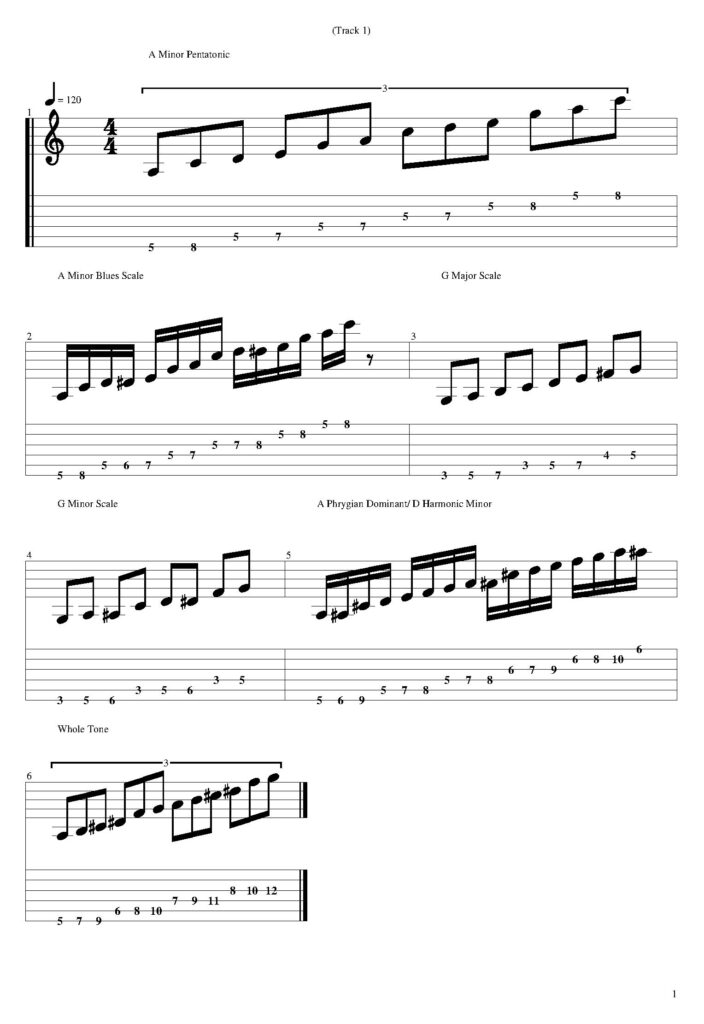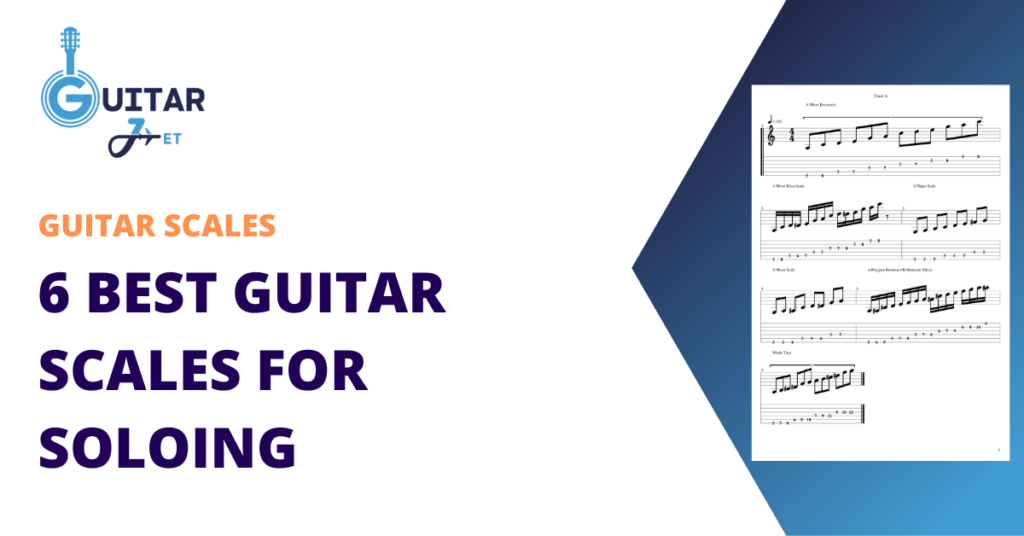Today you’re going to learn about the 6 best guitar scales for soloing.
Whether you’re a beginner looking to start playing guitar solos, or a seasoned player looking to refine your guitar skills, you’re in the right place.
Now let’s dive into these scales.
Table of Contents
All 6 best guitar scales for soloing (tab and notation)

Minor pentatonic scale
The #1 guitar scale for soloing is the minor pentatonic scale. If you’re just learning how to play guitar solos, then it’s definitely the first scale that you need to memorize.
Its formula is: 1-b3-4-5-b7
I suggest that you start by learning either A minor pentatonic or E minor pentatonic.
Now, there are a couple of reasons why the minor pentatonic scale is so popular.
First of all, it sounds awesome and it’s super easy to use.
Second of all, you can learn the minor pentatonic scale by memorizing five simple shapes. These shapes are played with two notes per string, and are very easy to visualize and move around the fretboard.
Minor blues scale
After you’ve learned the minor pentatonic scale, you need to learn the minor blues scale!
The minor blues scale is just a pentatonic scale with an additional note, the b5, which is called the blues note.
This gives it the formula: 1-b3-4-b5-5-b7
This simple chromatic tone adds a bluesy sound to your guitar licks, and will sound familiar to you if you listen to lots of blues and classic rock.
Major scale
Now we’ll move onto the most popular 7-note note scale: the major scale.
The major scale is a fundamental scale in music theory, which means that it’s also a fundamental scale for playing and writing guitar solos. It’s the most commonly heard scale in Western music, and is essential to learn if you want to understand diatonic harmony.
Its formula is: 1-2-3-4-5-6-7. This is easy to memorize because it doesn’t have any sharp or flat intervals.
I also recommend that you memorize its whole and half-step formula, which is: whole-whole-half-whole-whole-whole-half. Or think of it as: W-W-H-W-W-W-H.
The easiest major scale shapes to memorize for soloing are the three notes-per-string major scale shapes. These shapes take about a week to memorize, and make it effortless to move the major scale around the fretboard.
Natural Minor scale
As for modes of the major scale, the natural minor scale, also called Aeolian mode, is the 6th mode of the major scale, and is very common for soloing.
The natural minor scale, simply put, is the major scale played from its 6th degree.
It’s arguably the most popular scale for writing rock and metal music, and it’s generally associated with a “sad sound.
Its formula is: 1-2-b3-4-5b-6-b7. To make it easy to memorize, think of it as the major scale, but with a b3, b6, and b7.
You’ll especially want to remember the b6 interval, because that is the interval that makes the natural minor scale unique.
You can play the natural minor scale using the three notes per string major scale shapes that I mentioned earlier, so make sure you learn them!
Harmonic minor scale
The harmonic minor scale is a natural minor scale with a major 7th, rather than a minor 7th.
This particular interval gives it a somewhat “dark sound”, and is primarily used in metal guitar solos, especially in neoclassical metal.
The harmonic minor scale is easiest to play and understand once you’ve learned how to play the minor scale across the entire fretboard. From there, all you need to do is raise the 7th note in any natural minor scale position, and you’ll be playing the harmonic minor scale.
Whole tone scale
The last scale that I want to mention for soloing is the whole tone scale.
The whole tone scale is constructed entirely of whole steps, and that is why it has the name “whole tone scale”. Its whole-step construction makes it easy to learn, and easy to visualize both on a single-string and across the entire fretboard.
It’s a scale that’s often used in fusion, jazz, and other contemporary genres. Its primary role is to build tension in the music.
The last thing worth noting is that the whole tone scale is part of a family of scales called the Messiaen modes, which all have symmetrical scale formulas. These symmetrical scales are definitely worth taking a look at if you’re looking to learn advanced guitar scales.
PDF and Printable
Want to view the guitar scales for soloing in a PDF format? Then here it is.
You can also print it.
Guitar scales for soloing audio
Conclusion
I hope you enjoyed learning about the best guitar scales for soloing. Check out each scale, then try to write a guitar solo or improvise with your favorite one.
And if you want to keep learning with me and the community then join my Facebook group: The Guitar Techniques Society. Or, find it at facebook.com/groups/guitarjet.

